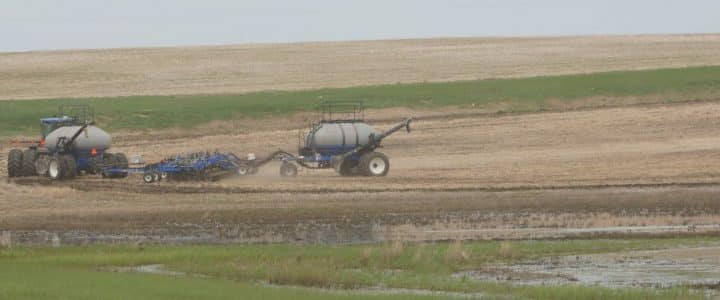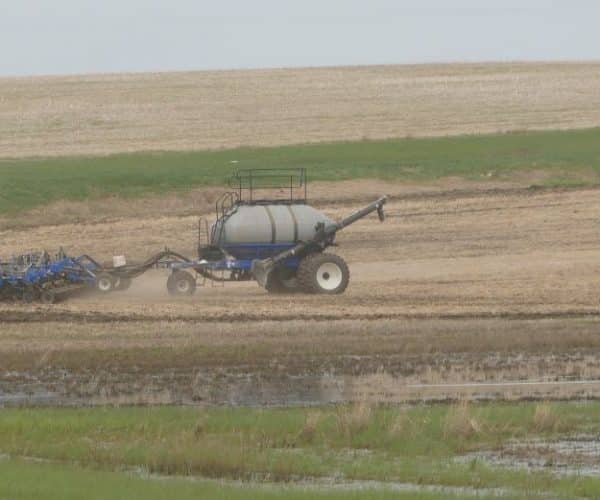Agriculture is full of innovative examples, and improvements to farm equipment over time is no exception. Farm equipment has increased in size and functionality and improved in efficiencies. Sectional control has also evolved from manual to automatic implement shut-off options to specific section sizes. The most precise automatic sectional-control technology on the market is currently individual opener control, which allows for shutting off and/or varying the product (seed, fertilizer, etc.) being applied and raising individual openers out of the ground over previously seeded areas, according to a recently-completed two-part sectional control research study led by Alberta Pulse Growers.
With the ability to reduce input costs and reduce economic losses and environmental impacts by preventing overlaps, sectional control can potentially make operations more productive and sustainable.
Summary of available sectional control technologies
Phase one of the ‘Evaluation of emission reductions and cost saving in sectional control air seeders, drills and sowing equipment across the Canadian Prairies’ project outlined the original equipment manufacturer (OEM) and aftermarket (AFT) sectional control technologies for air seeders, drills, and sowing equipment that are currently available in the Canadian Prairies, which are summarized in Table 1.
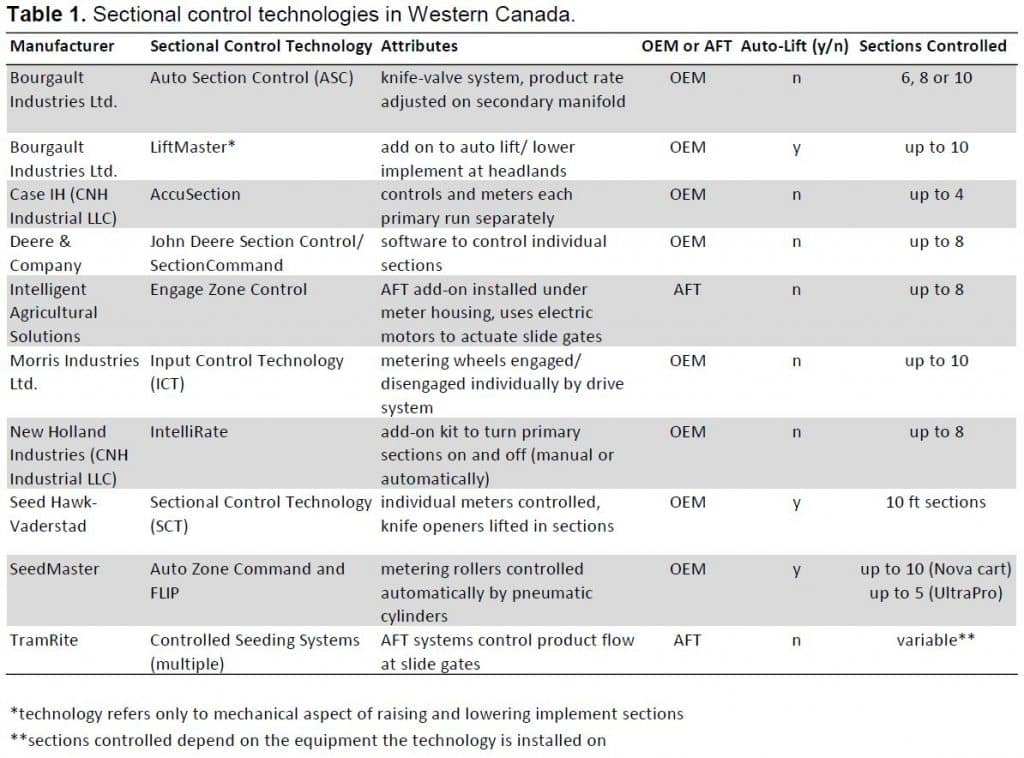
Sectional control effects on overlaps
The study also investigated the impacts (on input costs, crop effects and environmental effects) of sectional control technology on overlaps, reporting:
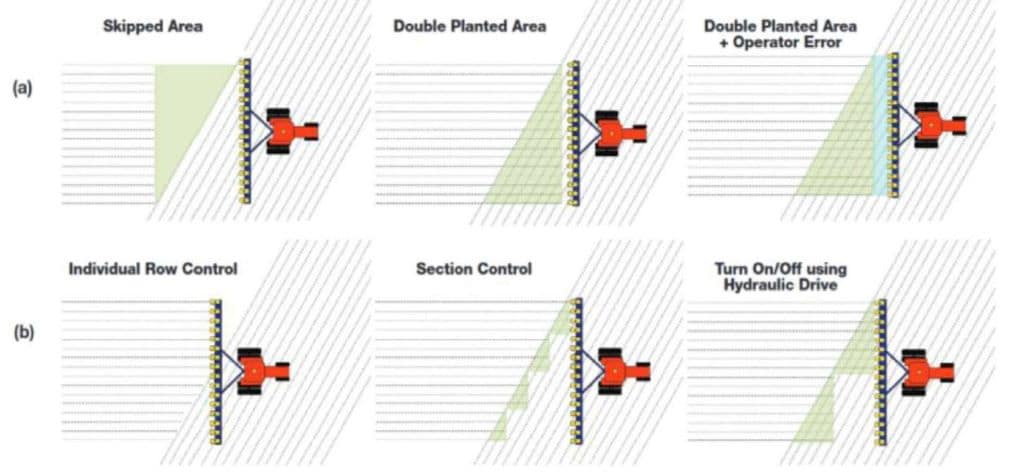
Brooke, 2014).
- Input costs – Though it is very difficult to measure precise savings due to field complexity (e.g. a perfectly square field will show less of a benefit than a misshapen field with many obstacles), the common result was that when used and managed properly, sectional control can result in cost savings.
- Crop effects – doubling inputs (at overlaps) can have negative effects on the crop, due to reduced stand uniformity.
- Overlaps can result in excessive plant densities (which could be favourable for disease development) and have negative impacts from production applications (including creating difficulty determining optimal spray timing for uneven maturity).
- Overlaps can also lead to lodging (making harvest extra difficult- especially when combined with managing areas of uneven maturity).
- Reducing overlap could potentially improve stand and maturity uniformity, making spray and harvest timing decisions more straightforward, which could produce a higher-yielding and more profitable crop.
- Environmental effects – overapplication of products can result in negative environmental impacts. Mobile nutrients in fertilizers (i.e. nitrogen in the NO form), as well as some forms of herbicides, that move with water could leach into water systems causing detrimental effects. Trying to avoid overlaps around obstacles can drive growers to drain sloughs or cut down tree bluffs to improve efficiency. If these obstacles provide habitat for pollinators, predators, and parasitoid insects, there could be an indirect impact on crop biodiversity as a result of obstacle removals.
Find more details on the different technologies and the overlap effects in the final report on the Hub and on the Alberta Pulse Growers’ site.
Testing the impacts of sectional control

Phase two of the ‘Evaluation of emission reductions and cost saving in sectional control air seeders, drills and sowing equipment across the Canadian Prairies’ project assessed profitability and potential environmental effects from using sectional control technology.
Three types of air seeder equipment were tested in-field in June 2020 to determine actual product overlap on both a pea and canola crop at a headland and around an obstacle:
- A 60-ft implement with eight sections measuring 7.5-ft each, and a 10-in. row spacing.
- An 84-ft implement with eight sections measuring between 10-ft and 12-ft each, and a 12-in. row spacing.
- A 100-ft implement with ten sections measuring 10-ft each, and a 15-in. row spacing.
Measurement method comparisons
Ground truthing of overlap measurements was conducted on three different pieces of equipment and a load cell was used to measure the draft of an implement when sections of an implement lifted at previously seeded areas. Different overlap scenarios were reviewed, and calculations were completed based on the scenarios to display potential additional costs of overlap.
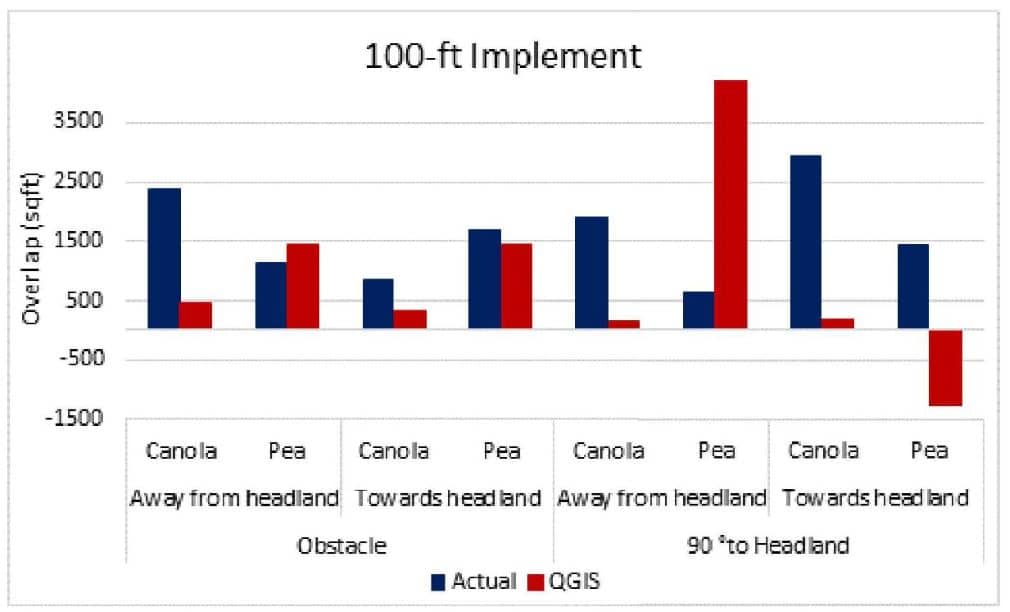
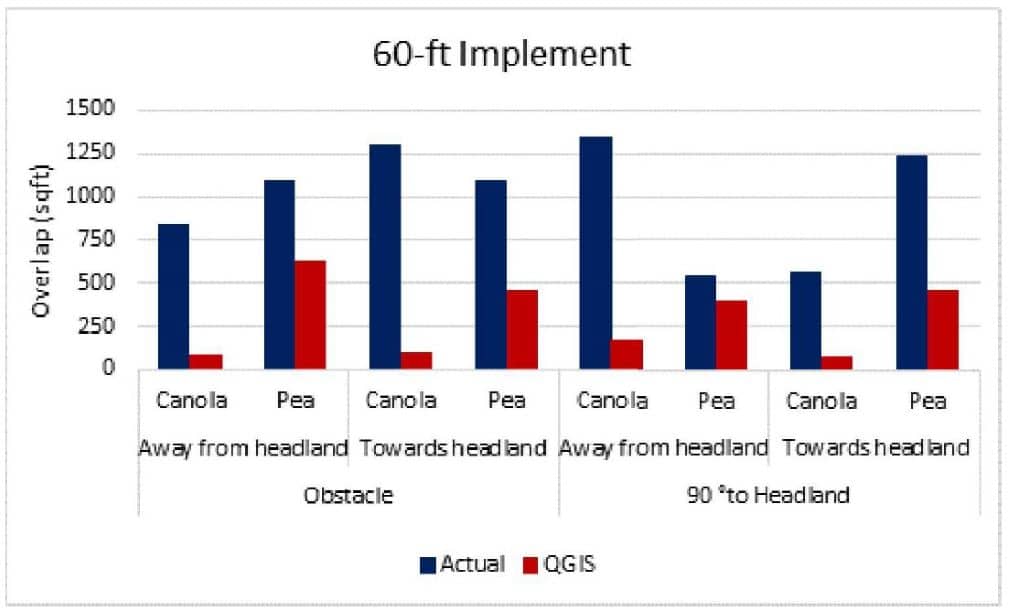
The overlap was determined to be greater in the canola crop (a small seed crop example) compared to the pea crop (a large seed crop example) when measured in the field, though the results varied between the headland and obstacle measurements.
In most cases the monitor indicates a substantially lower overlap amount when compared to what is actually measured in the field (see graph). So, while this displayed data is helpful, this research concluded that it may not be entirely accurate when referring to actual in-field product overlap measurements and there is still a need for ground truthing.
Katelyn Gaetz, the project lead on this study, recommended that farmers scout their fields to ground truth values, since the overlap on the monitors under-represented the actual overlap, in most cases.
Additional outcomes reported
- Based on this research, the actual overlap area in the field is typically greater than what is shown on the monitor and depending on the field size and shape and obstacles, overlap ranges from 1.3% to 2.5%.
- As can be expected, the implement and section size also influence the total overlap amount, with the greater the implement size and/or the greater the obstacle diameter, resulting in a greater overlap (as indicated by the difference between the two graphs).
- Draft measurements differ greatly with equipment type, size, and speed as well as soil properties, field topography, and many other variables.
- A direct correlation between the amount of implement in the ground versus the amount lifted out of the ground was reported in this study. As energy efficiency continues to become more important, technologies that reduce draft and benefit the grower may become more important.
- A decreased draft load can also be related to fuel and emission savings.
- The difference in power requirements when the openers are lifted can provide an indication of potential energy savings. Higher horsepower will result in higher fuel use (Natural Resources Canada, 2014), so as total horsepower declines while lifting implement sections, the potential for fuel savings exists when using this technology.
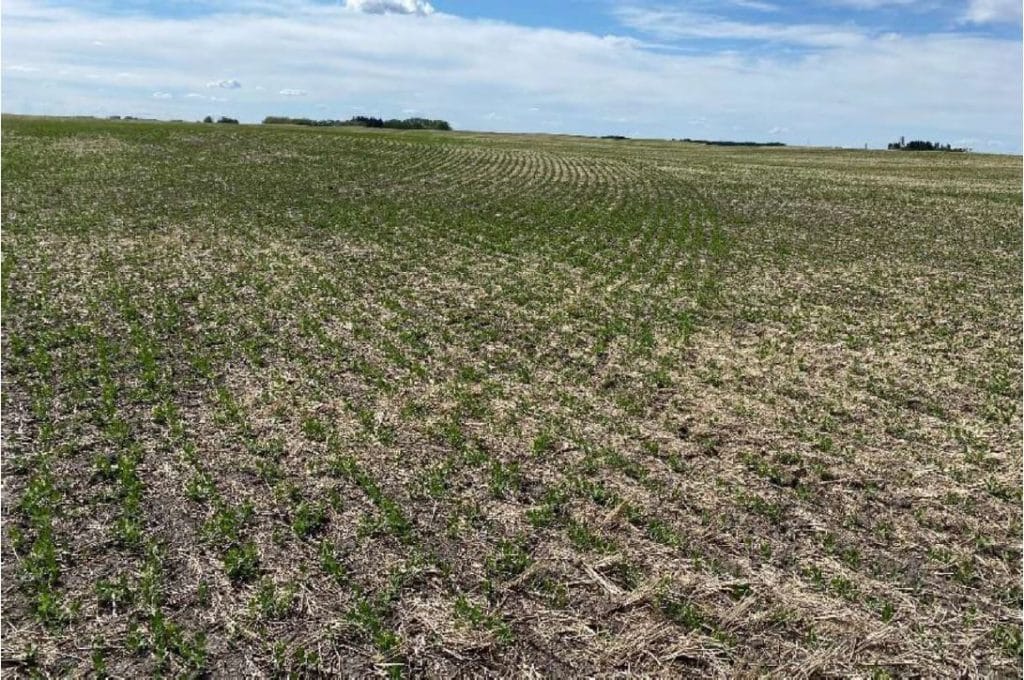
Agronomic effects
This study pointed out several negative agronomic impacts that can result from overlaps, including:
- Overlapped seeding/planting practices can lead to undesirable plant populations, crop lodging, and eventual harvest management challenges.
- Overapplied fertilizer has potential to harm the soil and create undesirable growing conditions for plants since many fertilizers have high salt levels, which can impact crop growth as well as negatively affect soil microorganisms. Ammonium fertilizers, in particular, can cause soils to become more acidic over time, creating adverse conditions for plant growth. Fertilizer toxicity or “burn”, typically caused by nitrogen, has the potential to severely damage seed and seedlings.
Whereas the implementation of GPS guidance systems can reduce manual stress on the equipment operator and sectional control technology provides the opportunity for better field management, by selectively manage smaller sections rather than the entire implement width.
Increased equipment sizes accentuate the need for efficient, productive and profitable operations (e.g. efficient use of input costs for seed, fertilizer, and herbicides). Large equipment also allows for fewer passes are needed in field, resulting in improved time efficiencies.
Environmental effects
Irregular fields with more obstacles, have an increased risk of overlaps which can impact nutrient management and wetlands that make up farmland.
Potential nutrient management impacts
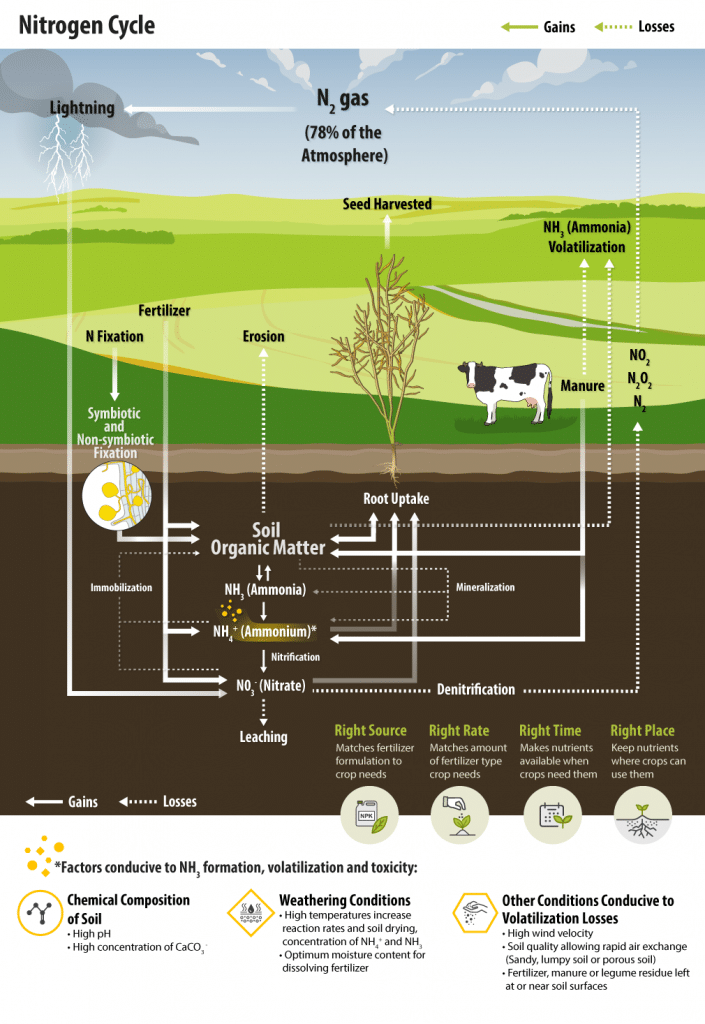
If fertilizer is being applied, an overlap could potentially leave excess fertilizer in specific areas.
Nitrogen losses can occur in three main ways: nitrate leaching, denitrification, and volatilization (Clark, 2014). Nitrate (NO3–) is extremely soluble, allowing it to readily leach through the soil. As the water moves both downward and laterally through the soil, the nitrate is carried with it and absorbed into the soil profile. This nutrient-enriched water can then leach from the desired area and contaminate both groundwater and above-surface waterbodies. Denitrification occurs in waterlogged soils (absent of oxygen) results in dinitrogen gas (N2) being released into the atmosphere. This process converts NO3– into N2 which then reacts with the ozone and contributes to air pollution (Bernhard, 2010). Volatilization losses are losses caused from the conversion of ammonium (NH4+) to ammonia gas (NH3). (See nitrogen cycle graphic for reference, which depicts the different forms of the nutrient, and places they may be found.)
The 4R Nutrient Stewardship concept (which specifies using the Right rate, Right source, Right time, and Right place when applying nutrients) is widely used in the industry to promote sustainable and productive farming practices. Using sectional control can help ensure the Right rate of the 4Rs can be adhered to minimize environmental risks and allows for the best use of crop nutrition.
Potential wetland stewardship impacts
Overlap increases when equipment navigates around obstacles, such as sloughs and wetlands. While wetlands play a significant role in ecosystem health by providing a habitat for many species, filtering chemicals, and storing soil carbon, they are generally considered ‘low production zones’ for annual crop production (producing low yields if planted).
Sometimes wetlands on field acres may be drained to create a more desirable, easy equipment path for navigation around the area. Therefore, by using more advanced agricultural equipment and technology, such as GPS and sectional control, wetland disruption can be more readily avoided and, in many cases, left intact.
Potential cost savings
When overlap is decreased on farm, there is an opportunity to realize potential cost savings, such as due to reduced inputs. Therefore, sectional control could potentially reduce total product purchased by producers, resulting in improved profitability, and reduced negative environmental impacts.
According to calculations in the Saskatchewan 2020 Crop Planning Guide (Saskatchewan Ministry of Agriculture, 2020):
- a 2% overlap in a 160-acre field growing canola can cost growers $578, $599 and $637 in the brown, dark brown and black soil zones, respectively
- a 20% overlap in a 160-acre field growing canola can cost growers $5775, $5992 and $6369 in the brown, dark brown and black soil zones, respectively.
These values include the average cost of seed, fertilizer, and machinery fuel and repair. Actual costs will vary depending on seed variety, fertilizer type, equipment specifics, and other factors.
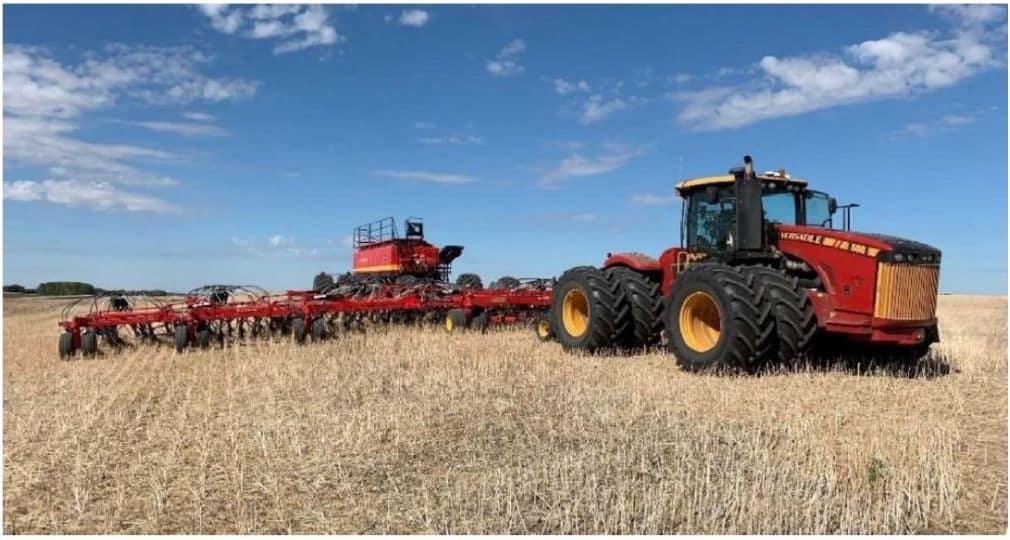
Further details, results and conclusions can be found in the project final report on the Canola Research Hub and on the Alberta Pulse Growers’ site.
Related research
Olds College has Smart Farm applied research projects available on their website, including reference to the phase one and two projects summarized above.
To check out the impact variable rate can have on potentially improving crop efficiencies in another western Canadian study, see ‘Variable nitrogen fertility management of canola at the field scale, based on analysis of yield maps and spatial and statistical variability of soil test nitrogen and phosphorous‘ on the Canola Research Hub.
For research on other precision farming and variable rate topics, check out these projects hosted on the SaskCanola and Alberta Canola research databases:
- Precision farming project
- Optimizing variable rate nitrogen fertilizer application in fields with spatial variability
- Understanding soil variability for effective zone management in precision agriculture – an evaluation of sensor based soil mapping
References
- Bernhard, A. (2010). The Nitrogen Cycle: Processes, Players, and Human Impact. Nature Education Knowledge.
- Clark, K. (2014). Nutrient Management to Improve Nitrogen Use Efficiency and Reduce Environmental Losses. Pennsylvania: The Pennsylvania State University.
- Natural Resources Canada. (2014). Learn the facts: Horsepower’s effect on fuel consumption. Natural Resources Canada.
- Runge, M., Griffin, T., Fulton, J., Virk, S., & Brooke, A. (2014, October). Automatic Section Control Technology for Row Crop Planters. Retrieved from Extension Alabama A&M Auburn Universities.
- Saskatchewan Ministry of Agriculture. (2020). Crop Planning Guide 2020.
Published October 8, 2021


